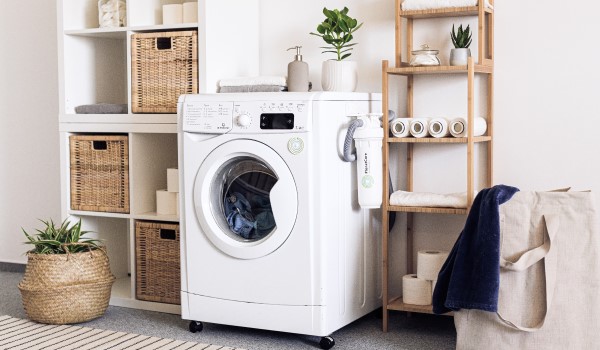Every penny counts right now in a ‘perfect storm’ of economic challenges. From food to fuel, monthly budgets are being squeezed, and families up and down the country are looking for ways to save money where they can. While it’s nigh-on impossible to reduce your bills at the moment, there are some short-term changes you might try and long-term investments you can make to decrease energy usage, mitigate against further increases, and support the environment, too.
Below we explore how to save on your electric, gas, and water bills. But, of course, some of these ideas may have high installation or set up costs when it comes to investing in your home so should always be considered as to whether you can afford these initial outlays.
Install LED bulbs
If you haven’t checked your light bulbs in a while, chances are you’re still running some traditional halogen or incandescent bulbs, which consume more energy than modern LED bulbs. LED is a highly efficient lighting technology and can save up to 90% energy compared to traditional light bulbs with the same light output. In terms of cost, Energy Saving Trust explains that you could spend up to £13 less per 100W bulb, per year.
It’s easy to make the swap. Simply check each ceiling, wall, and lamp bulb, and if they’re not already LED, make a note of the fitting type and brightness. After you’ve compiled your list, either order your bulbs online or head to your local DIY store. Then all that’s left to do is fit them.
Remember: while energy-efficient light bulbs can be recycled at local centres, traditional light bulbs can’t, so dispose of them with your household waste.
Optimise your clothes washing routine
It might come as a surprise that heating the water in a washing machine can really push up energy costs. Which? did some research and found that tested turning down the temperature from 40 degrees to just 20 degrees reduced running costs of the machines they tested by an average of 62%. Of course, this low temperature may not get some stains out and Which? found that the cleaning power was less but they added that switching to a liquid detergent can combat this and is effective enough for everyday cleaning.
If you’re keen to find a middle ground here between cost and effectiveness of your washing machine, then washing at 30 degrees could be your answer as this still used 38% less energy than washing at 40 degrees but you’re still getting a good wash. If it’s bacteria that you’re wanting to bust with a hotter machine, then remember that this could be down to your detergent more than the heat because even at 60 degrees some bacteria and viruses are still resistant.
You could also consider using your washing machine less. Ensuring the machine has a full load for every cycle will help, so you could try asking around the house before you turn it on if you’ve only a small amount to wash or simply hand wash or wait until there’s more to load up with!
Swap the oven for the microwave if you can
Are there any dishes you find equally tasty when cooked in a microwave? If so, you might try regularly making the swap, because the small, portable appliance uses considerably less energy. This is because it heats the food only, rather than a large compartment, like a traditional oven does. A Uswitch expert said that cooking a baked potato in the microwave costs around 3p compared to 27p in the oven.
Alternatively, you could experiment with a slow cooker, which uses less energy with lower temperatures. The example used here is a casserole, which would cost around 22p to cook in the slow cooker or 54p in a conventional oven.
Set your heating on a timer
British weather, particularly in winter, can see the mercury drop to below 0. And as much as temptation wants the heating on all the time, Energy Saving Trust explains that leaving it on low all day for lower energy usage is a myth. That’s why it could be more cost-effective to only use the heating when you need it most – and setting a timer is the easiest way to do this.
Before you set your timer, think about how your home is used. Is everyone up before dawn? Are people home all day? Does the house fill up again after 7pm?
Whatever your typical routine looks like, set the heating timer around that. For example, you could set the heating for 1 hour just before everybody rises. Then if your house is empty all day, you could set it again for a couple of hours in the evening when everyone is due home – ideally after sunset when the drop in temperature is most noticeable.
Some boilers come with a 1-hour boost setting if you need extra warmth on a particularly cold day. If you switch your heating on outside of the set times or 1-hour setting, don’t forget to switch it off again.
Use water-saving gadgets
There are numerous nifty devices available that can help you reduce the amount of water you use throughout your home. A water-efficient showerhead, for example, uses as little as 7-8 litres per minute, as opposed to a standard 10-15 litres. Plus, remember that baths of course use lots more water, around 80 litres, so as relaxing as they are they’re perfect for a treat if you’re trying to save water usage. A five-minute shower at 7 litres a minute will only use around 35 litres.
You could also use a shower timer to ensure you’re in and out quickly; a cistern bag to reduce the amount of water used per flush; and a sink plug to avoid free-running water to wash dishes or fruit and vegetables. Some water companies offer free water-saving gadgets, so contact them before you buy.
Invest in renewables (long-term solution)
If you have more money to invest in cost-saving, energy-efficient solutions, there are several renewable options to consider that can help reduce your electricity bill over the long term.
The most popular choice for home installation is solar panels, which are usually attached to your roof. According to Energy Saving Trust, a typical household with a 4.2 kilowatt-peak system can save between £165 and £405 per year on bills.
The initial outlay for installation needs to be taken into account when calculating savings, which will vary depending on the size and type of your chosen system. The most popular size is a 4kW solar panel system which costs between £5,000 and £6,000. This is usually made up of between 10 and 15 panels. Alternatively, a 3.5kW system costs around £4,800 including labour, consisting of around 12 panels. Depending on your circumstances, you could qualify for a grant through the government’s The Green Deal, to help with the cost of installation.
Ensure your home is well-insulated (long-term solution)
Another investment for longer-term gains is home insulation. A well-insulated home is not only good for your heating bill, because you’ll be less inclined to turn up the thermostat, but it’s also great for the health and condition of your home. That’s because it helps retain more dry, warm air and heat within the home, preventing damp and mould from developing.
New builds are generally better insulated than older homes, but that’s not to say you can’t retrofit insulation. There are several options available, including loft and roof insulation, cavity wall and solid wall insulation, underfloor insulation and window glazing.
A recent Energy Performance Certificate (EPC) of your home may detail what insulation, if any, your home has already. Or you could contact a local insulation company for their advice, as well as a quote. You may also qualify for a home insulation grant through The Green Deal, mentioned above.
Costs and savings differ depending on house type and age, plus how much energy is currently used, but we’ve used a detached house example from Energy Saving Trust to highlight potential figures below:
- Cavity wall insulation would cost around £2.5k with a potential saving of £480 per year.
- Loft insulation would cost around £680 with a potential saving of £580 per year.
- Suspended underfloor insulation would cost around £1.3 to 2.7k with a potential saving of around £120 per year.
As stated earlier, for long term investment in renewables and insulation you should consider the cost of implementing these changes when measured against the savings you’ll achieve. For more money-saving tips, read our savings guides, use the budget planner tool to help organise your finances, or visit our blog to discover more helpful articles.









